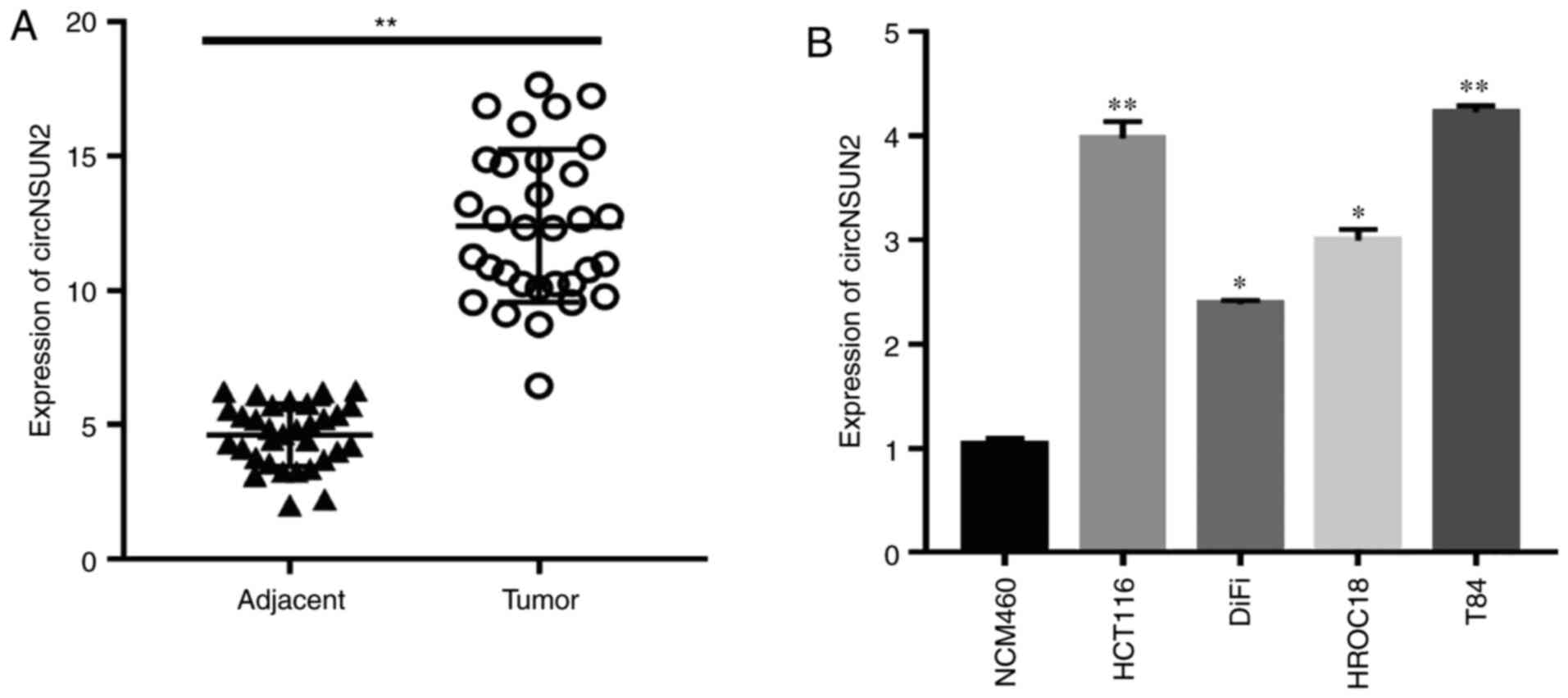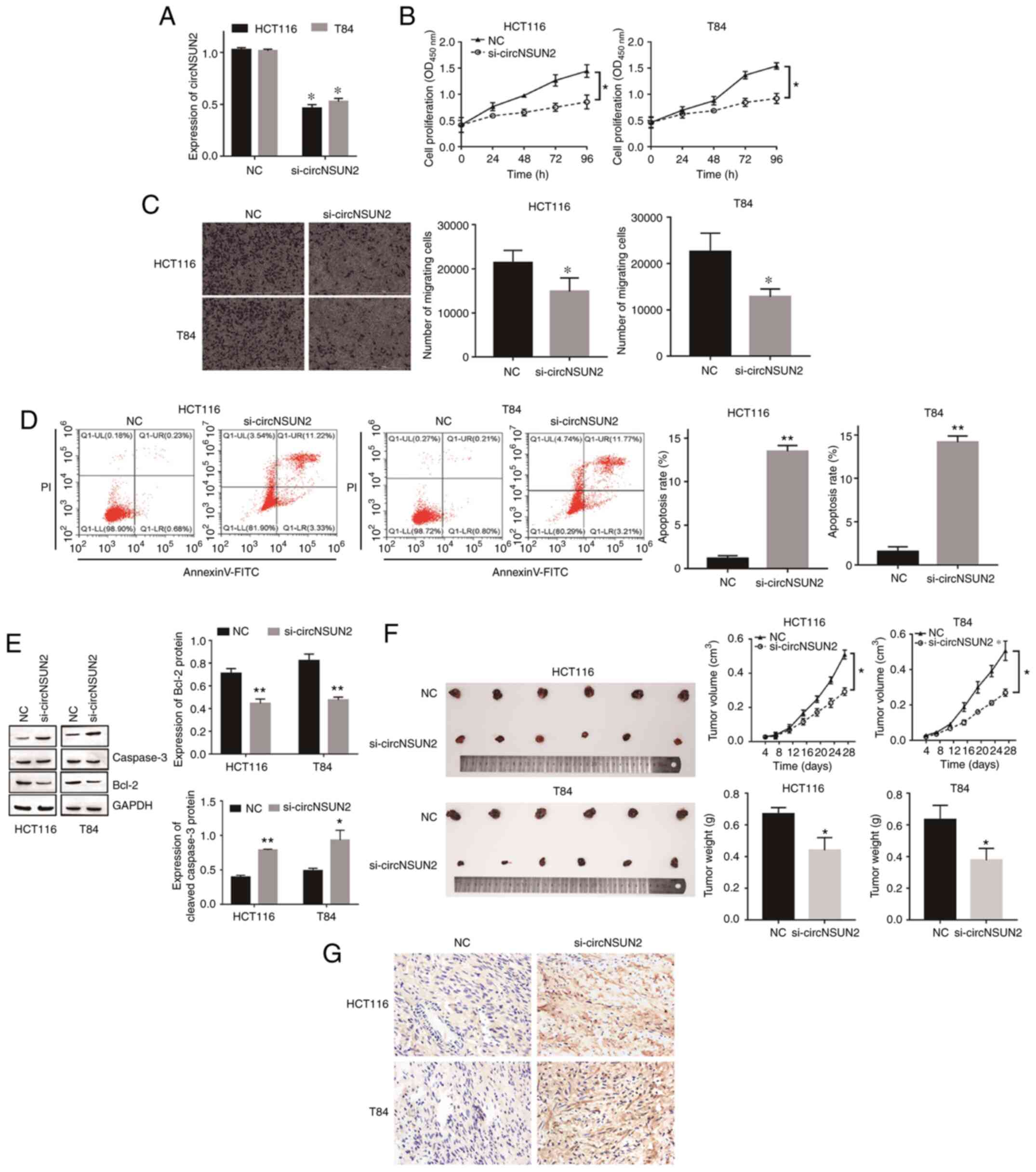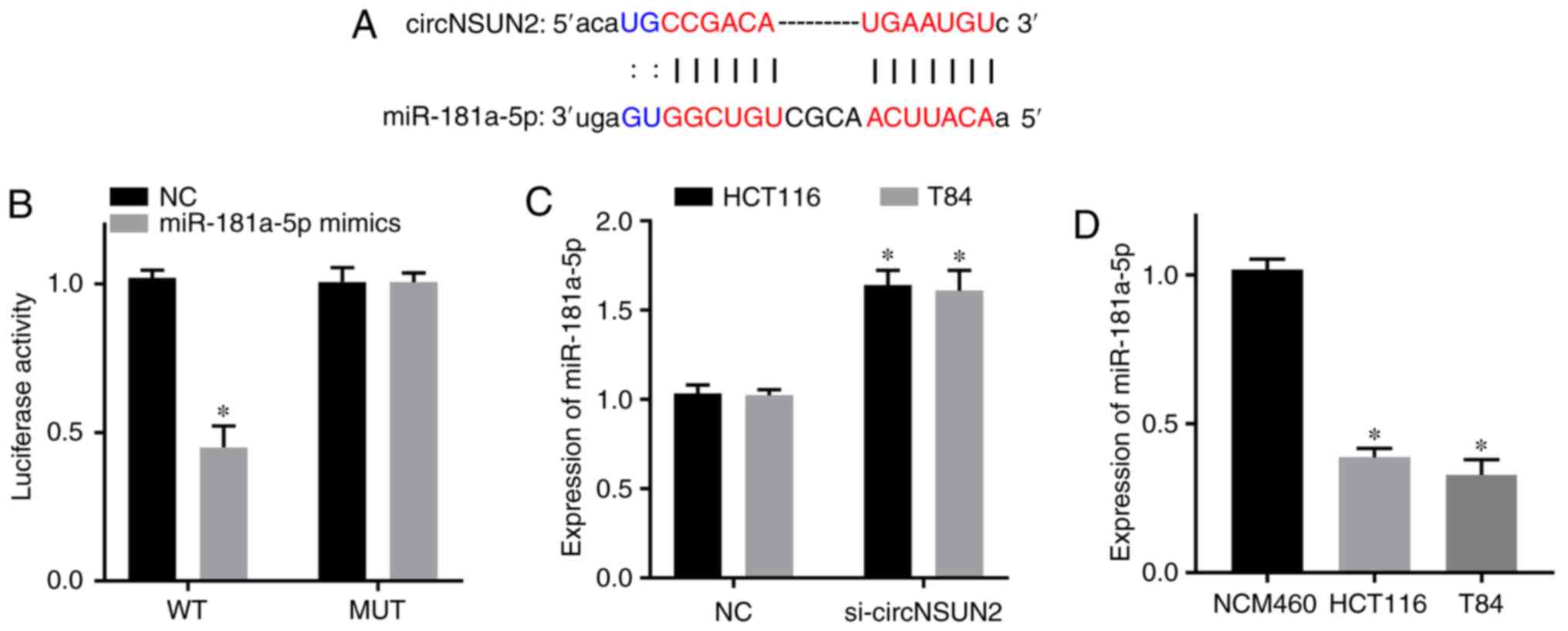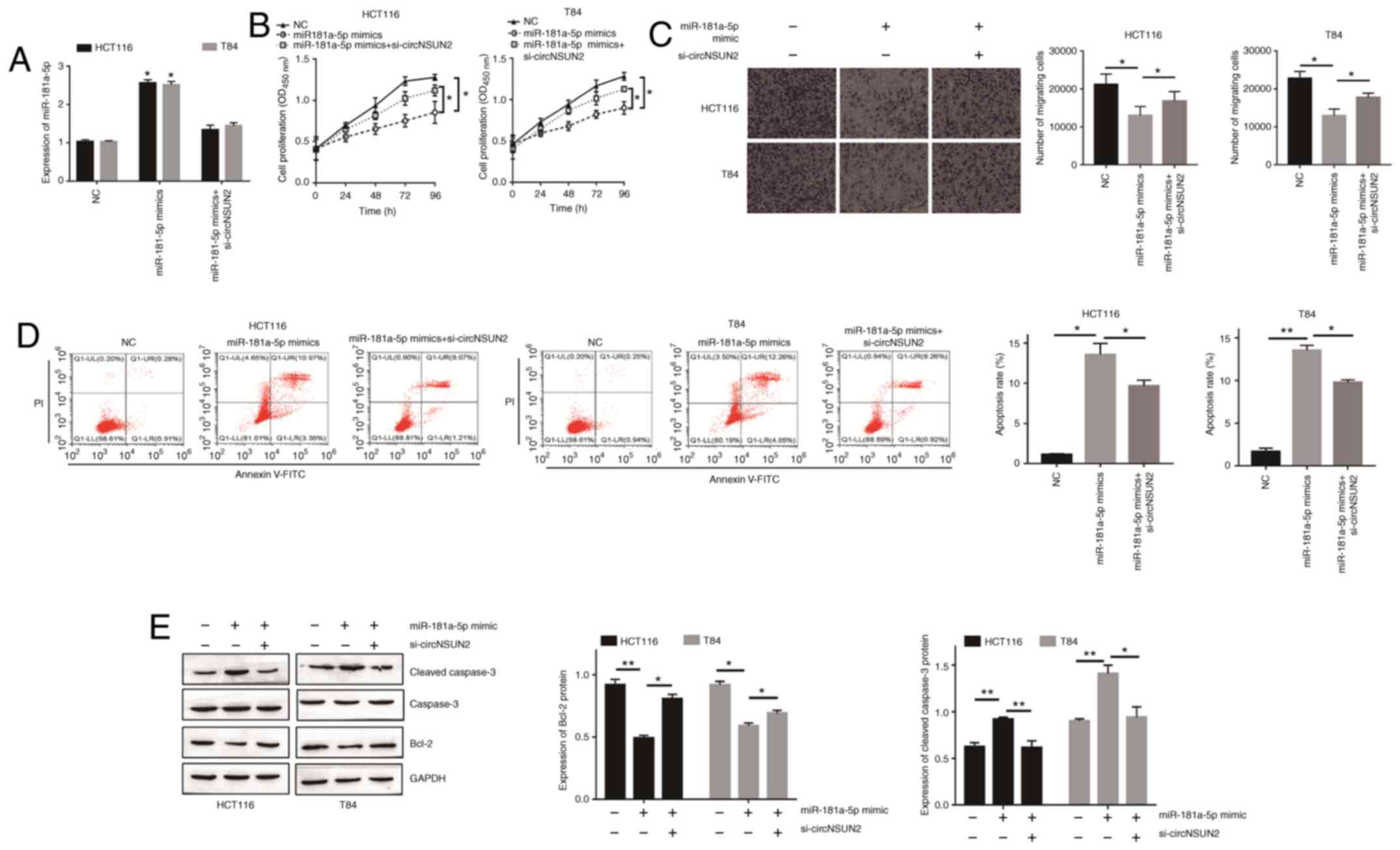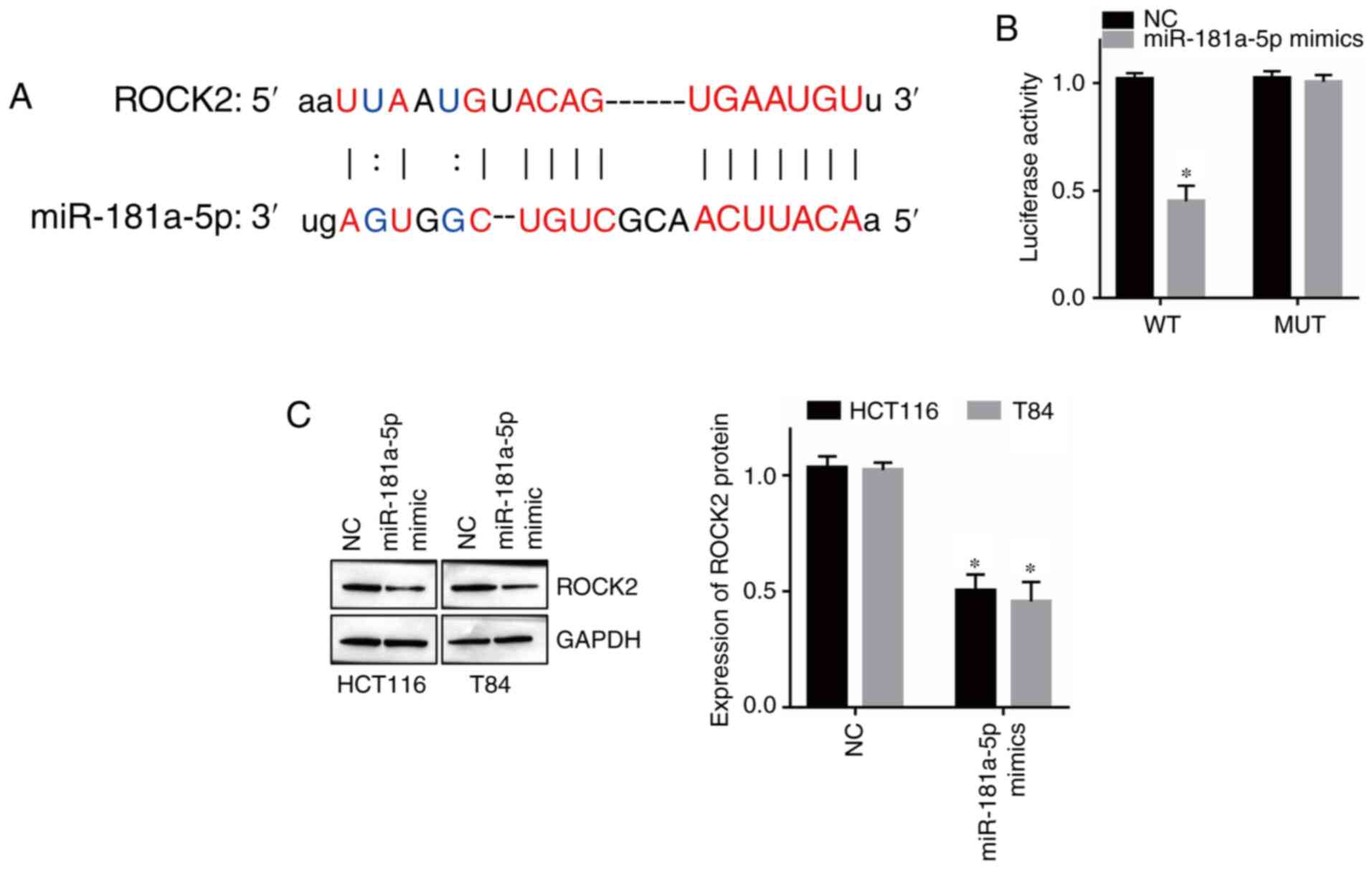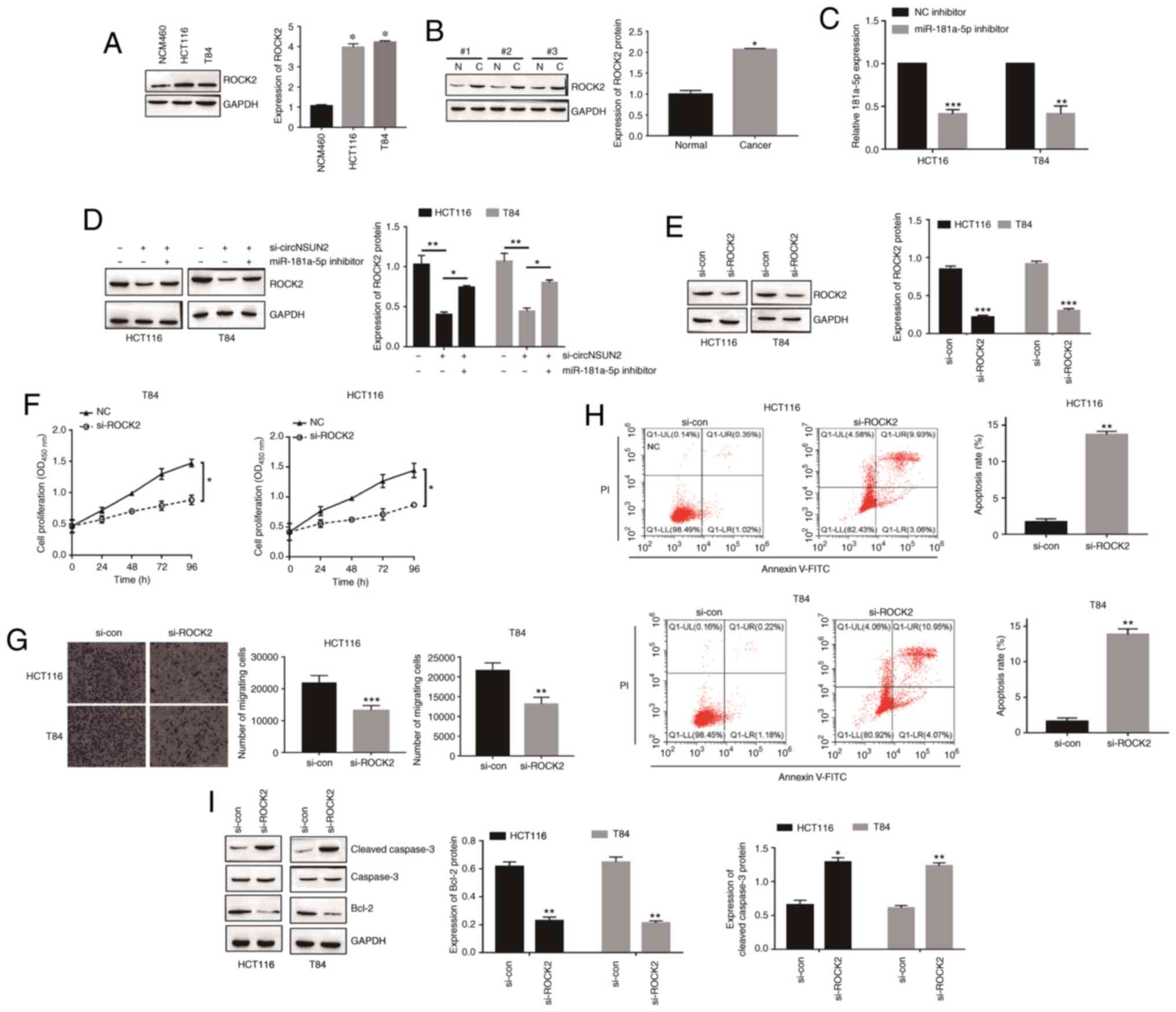circNSUN2 promotes the malignant biological behavior of colorectal cancer cells via the miR‑181a‑5p/ROCK2 axis
Retraction in: /10.3892/or.2023.8672
- Authors:
- Published online on: May 27, 2021 https://doi.org/10.3892/or.2021.8093
- Article Number: 142
-
Copyright: © Chi et al. This is an open access article distributed under the terms of Creative Commons Attribution License.
Abstract
Introduction
Colorectal cancer (CRC) is the third most common cancer worldwide (1), and with changes in diet and lifestyle, the incidence of CRC is continuously increasing (2). The risk of CRC is due to increased migration and invasion of CRC cells. The high migration and invasion of CRC cells promotes the progression of CRC (3,4). In addition, the high migration and invasion of CRC cells also leads to poor prognosis of CRC patients after surgical resection (5). Therefore, it is necessary to find effective targets for CRC.
Circular RNAs (circRNAs) are a class of noncoding RNAs that have been revealed to be involved in numerous human diseases including cancer (6,7). Recent studies have indicated that circRNAs play vital roles in cancer development and may serve as novel therapeutic targets for cancer (8–10). In the present study, the function of circRNA NOP2/Sun domain family, member 2 (circNSUN2) and underlying mechanisms in the development of CRC were examined.
It has been reported that circRNAs function as microRNA (miRNA) sponges to regulate the expression of target mRNAs. For example, it has been revealed that miR-3187-3p, as a sponge of circ-ITGA7, regulated ASXL1 by inhibiting the proliferation of CRC (11). Huang et al (10) demonstrated that circAKT3 activated PIK3R1 via downregulation of miR-198 and enhanced cisplatin in gastric cancer. miR-181a-5p, which is involved in the development of cancer, has been widely reported. A previous study revealed that miR-181a-5p, as a sponge of circ-0068871, regulated the progression of bladder cancer (12). Notably, the aberrant expression of miR-181a-5p in CRC has also been reported (13). Moreover, based on bioinformatics data, miR-181a-5p has been revealed to be one of the target genes of circNSUN2. In addition, Rho-associated coiled-coil-containing protein kinase 2 (ROCK2), an effector of the small GTPase Rho, has been identified as a target of miR-181a-5p. ROCK2 has been revealed as a key element in cancer growth and progression (14,15). However, to the best of our knowledge, there have been no studies concerning the effect of the circNSUN2/miR-181a-5p/ROCK2 axis on the development of CRC.
In the present study, the expression levels of circNSUN2, miR-181a-5p and ROCK2 in CRC were detected, and the relationship between circNSUN2, miR-181a-5p and ROCK2 was verified. Furthermore, the underlying mechanism of the effect of circNSUN2 on the malignant biological behavior of CRC was demonstrated. The present study thus suggests a previously unknown role of circNSUN2 in CRC and provides the mechanism of circNSUN2 in malignant biological behavior of CRC.
Materials and methods
Tissue samples
Human colorectal cancer tissues and adjacent tissues were collected from 32 patients at the First Affiliated Hospital of Kunming Medical University between December 2018 and June 2019. These patients included 18 males and 14 females. The age range of patients was 20–60 years old with an average age of 40.57±11.24 years. The present study was approved by the Ethics Committee of First Affiliated Hospital of Kunming Medical University (Ethical approval no. 2018-L-41) and all patients provided informed consent.
Cell culture
The human normal colonic epithelial cell line NCM460 (item no. MJ-550) was purchased from Shanghai Mingjing Biotechnology Co., Ltd. The colorectal cancer cell line HCT116 (item no. C4111) was purchased from Shanghai Guandao Biotechnology Co., Ltd. The colorectal cancer cell line DiFi (BSC-5023479758-01) was purchased from Shanghai Binsui Biotechnology Co., Ltd. The colorectal cancer cell line HROC18 (product no. CE18870) was purchased from Beijing Crisprbio Biotechnology Co., Ltd. The colorectal cancer cell line T84 (product no. YB-H3024) was purchased from Shanghai Yubo Biotechnology Co., Ltd. 293T cells (cell bank no. KCB200744Y) were obtained from the Chinese Academy of Sciences. Cells were cultured in RPMI-1640 culture medium (product code 0050001DJ; Invitrogen; Thermo Fisher Scientific, Inc.) with 10% fetal calf serum (item no. 21097; Cayman Chemical Company), 100 U/ml penicillin and streptomycin (product code DXT-11074440001; Roche Diagnostics). Cells were maintained at 37°C and 5% CO2.
Cell transfection
Small interfering (si)-circNSUN2 (5′-AUCAUAAGGUAUCCUGAAGAACUUG-3′), and circNSUN2 si-negative control (NC) (5′-UUCUCCGAACGUGUCACGUTT-3′), miR-181a-5p inhibitor (5′-ACUCACCGACAGCGUUGAAUGUU-3′), and miR-181a-5p inhibitor NC (5′-CAGUACUUUUGUGUAGUACAA-3′), si-ROCK2 (5′-GGATAAACATGGACATCTA-3′) and si-con (5′-CAGUACUUUUGUGUAGUACAA-3′), miR-181a-5p mimic (5′-AACAUUCAACGCUGUCGGUGAGU-3′) and miR-181a-5p NC mimics (5′-UUUGUACUACACAAAAGUACUG-3′) were constructed by Guangzhou RiboBio Biotechnology Co., Ltd. The HCT116 and T84 cells (2×105) were seeded in a 6-well plate, and NC (50 nM), si-circNSUN2 (50 nM), NC mimics (50 nM), miR-181a-5p mimics (50 nM), miR-181a-5p inhibitor (100 nM), si-con (100 nM) and si-ROCK2 (100 nM), were transfected by Lipofectamine 2000 transfection reagent (item no. J44705; Duoxi) at 37°C for 24 h according to the manufacturer's protocol.
Reverse transcription-quantitative (RT-q) PCR
RT-qPCR was used to examine the expression of circNSUN2 and miR-181a-5p. TRIzol reagent (cat. no. 15596018; Invitrogen; Thermo Fisher Scientific, Inc.) was used to extract tissue and cell RNA. The total RNA (1 µg) was used as template for cDNA synthesis using SuperScript III Reverse Transcriptase (cat. no. 18080093; Invitrogen; Thermo Fisher Scientific, Inc.). The tissue and HCT116 or T84 cell cDNA was diluted for PCR amplification using SYBR Green PCR Master Mix (product code SR1110; Solarbio Life Sciences). RT-qPCR was performed at 95°C for 1 min, 40 cycles at 95°C for 10 sec and 58°C for 40 sec. The following primer sequences were used: circNSUN2 forward, 5′-GGAUACCUUAUGAUGAGGCCGC-3′ and reverse, 5′-UGAGGAGCAGUGGUGGGAUC-3′; miR-181a-5p forward, 5′-CGGCAACATTCAACGCTGT-3′ and reverse, 5′-GTGCAGGGTCCGAGGTATTC-3′; ROCK2 forward, 5′-CTAGGCCGGGCGAAG-3′ and reverse, 5′-TCCAGCTTCCTCTGACGAC-3′; GAPDH forward, 5′-GGTGCTGAGTATGTCGTGGAGTCTA-3′ and reverse, 5′-TCTTGAGGGAGTTGTCATATTTCTC-3′; U6 forward, 5′-CTTCGGCAGCACATATAC-3′ and reverse, 5′-GAACGCTTCACGAATTTGC-3′. GAPDH and U6 were used as internal controls. The 2−ΔΔCq method was used to normalize the fold change in expression (16).
Western blotting
Total protein was isolated from tissue and cells using RIPA lysis (cat. no. 28191; Norgen Biotek) was used to extract total protein. A BCA kit (cat. no. C-0018-30; Bioss) was used to determine the protein content. After denaturation, the proteins (5 µg) were separated by 10% SDS-PAGE and transferred to PVDF membranes. A solution of 5% skimmed milk was used to block the membranes at room temperature for 1 h. Then, the membranes were incubated with anti-caspase-3 (1:500 dilution; product code ab4051; Abcam), anti-cleaved caspase-3 (1:500 dilution; product code ab32042; Abcam), anti-ROCK2 (1:1,000 dilution; cat. no. orb251570; Biorbyt, Ltd.), anti-GAPDH (1:1,000 dilution; cat. no. G13-61M-100; SignalChem Biotech, Inc.) at 4°C overnight, followed by incubation with secondary antibodies IHC Select Streptavidin-HRP (1:1,000 dilution; cat. no. 20774; EMD Millipore) at room temperature for 2 h. The enhanced chemiluminescence kit (cat. no. orb90502; Biorbyt, Ltd.) was used to visualize the immunoreactive signals. GAPDH was used as an internal control. ImageJ 1.8.0 software (National Institutes of Health) was used to quantify the density of target bands.
Cell Counting Kit-8 (CCK-8)
CCK-8 (item no. R22305; Shanghai Yuanye Bio-Technology, Co. Ltd.) was used to examine cell proliferation. HCT116 cells and T84 cells (5,000 cells/well) /well were plated into a 96-well plate and then cultured in an incubator (37°C, 5% CO2). After 48 h, 10 µl of CCK-8 was added into each well at 0, 24, 48, 72 and 96 h. Then, after 1 h, the optical density at 450 nm was measured by a microtiter plate reader.
Flow cytometry
Flow cytometry was used to examine the cell apoptosis rate. HCT116 cells and T84 cells (5,000 cells) were collected using trypsin and washed with PBS. Then, an Annexin V-FITC/PI apoptosis detection kit (cat. no. 556547; BD Biosciences) was used according to the manufacturer's instructions. The fluorescence intensity of the cells was quantified by flow cytometry (BD FACSCalibur™). Flow cytometry analysis was performed using FlowJo10.0.0 (FlowJo, LLC).
Cell migration assay
A Transwell assay was used to evaluate HCT116 and T84 cell migration ability using Transwell chambers (8-µm pore size; cat. no. MCEP06H48; EMD Millipore). Cell suspensions (100 µl cell suspension/well) were prepared in serum-free medium and plated in the upper chamber, while the lower chamber was filled with medium containing 10% FBS (cat. no. DXT-10099141, Gibco; Thermo Fisher Scientific, Inc.). The chamber was incubated for 24 h at 37°C. After 24 h, the cells in the upper chamber were removed with a swab, and the cells that migrated into the lower chamber were fixed in 75% methanol (item no. JKLN042113; Shanghai Jingke technology Co., Ltd.) for 30 min and stained with 1% crystal violet (item no. J12750; Duoxi) for 1 h at room temperature. The migrated cells were observed and imaged under a light microscope at a magnification of ×40 in 5 randomly selected visual fields in each group.
Dual-luciferase reporter assay
The binding sites between circNSUN2 and miR-181a-5p and between miR-181a-5p and ROCK2 were predicted by starBase2.0 (http://starbase.sysu.edu.cn/) and TargetScan7.1 (http://www.targetscan.org/vert_71/). A dual-luciferase reporter assay was used to verify the relationship between circNSUN2 and miR-181a-5p and between miR-181a-5p and ROCK2. The circNSUN2 or ROCK2 region containing wild-type (WT) or mutant (MUT) binding sites of miR-181a-5p were cloned into pGL4.49 vector (cat. no. E4611; Promega Corporation). The 293T cells were plated and co-transfected with vectors by Lipofectamine 2000 according to the manufacturer's protocol. After 48 h, the luciferase activity was determined by a Dual-luciferase Reporter Assay kit (cat. no. K801-200, BioVision, Inc.). Firefly luciferase activity was normalized to Renilla luciferase activity.
In vivo tumor growth assay
An in vivo tumor growth assay was used to examine tumor growth. All animal experiments were approved by the Experimental Animal Ethics Committee of Kunming Medical University and adhered to international guidelines for proper animal care and maintenance. Nude mice (n=24; male; 3–4 weeks old; weight 19–25 g) purchased from the Animal Center of Kunming Medical University were randomly separated into four groups and housed in a pathogen-free facility (28°C; 55% humidity; 12-h light/dark cycle with food and water ad libitum). Approximately 1×106 HCT116 and T84 cells with stable expression of si-circNSUN2 and NC were subcutaneously injected into BALB/C nude mice. Mice were under daily monitoring. The tumor volume was monitored at 4, 8, 12, 16, 20, 24, and 28 days using manual calipers after injection. Tumors were obtained at 4 weeks after injection. At the end of the experiment, six nude mice in each group were euthanized by anesthesia-mediated by overdose pentobarbital sodium via intravenous injection and tumors were harvested. The sacrifice of mice was confirmed by cessation of breathing and heartbeat which were monitored. The maximal tumor volume allowed in this experiment was 1.8 cm3. The tumor volume was measured according to the following equation: (width)2x(length/2).
TUNEL staining
TUNEL staining was used to evaluate tumor apoptosis. The tumors were removed from the mice, fixed in 4% formaldehyde at room temperature for 24 h and then embedded in paraffin. Then, the tumors were sectioned into 4-µm sections and adhered to slides. A TUNEL kit (cat. no. 4500-0121-1; Merck KGaA) was used to stain the sections at 37°C for 30–60 min according to the manufacturer's instructions. After washing the slides with PBS and air drying, the apoptotic cells were assessed in 10 randomly selected fields under a confocal microscope at a magnification of ×40.
Statistical analyses
The data are presented as the mean ± standard deviation (SD). Statistical analysis was performed using SPSS 17.0 software (SPSS, Inc.). He statistical significance of differences between two groups was evaluated by paired Student's t-test and significant difference between more than two groups was evaluated with one-way ANOVA by Tukey's post hoc test. P<0.05 was considered to indicate a statistically significant difference.
Results
Expression of circNSUN2 in CRC tissues and cell lines
circRNAs have been revealed to be aberrantly expressed in various tumors (17)
In the present study, the expression of circNSUN2 was examined in colorectal cancer tissues and cell lines by RT-qPCR. The results revealed that circNSUN2 was highly expressed in colorectal cancer tissues compared with adjacent tissues (Fig. 1A; P<0.01). Moreover, the expression levels of circNSUN2 were higher in CRC cell lines, especially in HCT116 and T84 cells (Fig. 1B; P<0.05 and P<0.01) compared with NCM460 cells. Therefore, HCT116 and T84 cells were selected for the following experiments. Notably, the aforementioned results indicated that circNSUN2 was highly expressed in CRC tissues and cell lines.
circNSUN2 promotes proliferation, migration and inhibits apoptosis of CRC in vivo and in vitro
To determine the function of circNSUN2 in CRC, circNSUN2 was first knocked down in HCT116 and T84 cells by specific siRNA and the transfection efficiency was validated by RT-qPCR (Fig. 2A; P<0.05). Functionally, CCK-8 assays and Transwell assays revealed that inhibition of circNSUN2 attenuated cell proliferation and migration, while flow cytometric assays and western blot assays indicated that inhibition of circNSUN2 promoted cell apoptosis (Fig. 2B-E; P<0.05 and P<0.01). Moreover, the in vivo tumor growth assay results revealed that knockdown of circNSUN2 inhibited tumor growth in terms of both volume and weight (Fig. 2F; P<0.05). In addition, TUNEL staining results revealed that compared with the NC group, the apoptosis of tumor cells in si-circNSUN2 group increased (Fig. 2G). Hence, knockdown of circNSUN2 markedly inhibited the malignant biological behavior of CRC in vivo and in vitro.
Relationship between circNSUN2 and miR-181a-5p
Based on the results from the bioinformatics database starBase, miR-181a-5p was predicted to be a target gene of circNSUN2 (Fig. 3A). Dual-luciferase reporter assay results revealed that the luciferase activity of the circNSUN2 WT reporter was decreased in the miR-181a-5p mimics group, but the luciferase activity of the circNSUN2 MUT reporter was not significantly different from that of the NC group (Fig. 3B; P<0.05). Moreover, RT-qPCR results revealed that the expression level of miR-181a-5p was increased in the si-circNSUN2 group of HCT116 and T84 cells (Fig. 3C; P<0.05). In addition, RT-qPCR results revealed that the expression levels of miR-181a-5p in the CRC cell lines HCT116 and T84 were decreased compared with those in the normal colonic epithelial cell line NCM460 (Fig. 3D; P<0.05). Therefore, circNSUN2 targeted miR-181a-5p and downregulated its expression in the CRC cell lines HCT116 and T84. In addition, miR-181a-5p was downregulated in CRC cell lines.
miR-181a-5p is involved in the development of CRC and dysregulated by circNSUN2
In order to determine the role of miR-181-5p in circNSUN2-mediated malignant biological behavior of CRC cells, miR-181a-5p mimics transfection was performed. The transfection efficiency was determined by RT-qPCR (Fig. 4A; P<0.05). As revealed in Fig. 4B and C, miR-181a-5p overexpression resulted in decreased proliferation rates and migration abilities of HCT116 and T84 cells (P<0.05). Moreover, forced miR-181a-5p expression increased the apoptotic rate of HCT116 and T84 cells (Fig. 4D and E; P<0.05 and P<0.01). In addition, rescue experiments were performed to validate the relationship between circNSUN2 and miR-181a-5p. Transfection of HCT116 and T84 cells with si-circNSUN2 had a significant influence on miR-181-5p overexpression-mediated malignant biological behavior (Fig. 4A-E). Overall, these results indicated that overexpression of miR-181-5p attenuated the effects of circNSUN2 inhibition on HCT116 and T84 cell behaviors.
miR-181-5p directly targets ROCK2
miRNAs function by modulating the expression of target genes (18). According to bioinformatics analysis, ROCK2 was revealed as a target of miR-181a-5p (Fig. 5A). Moreover, dual-luciferase reporter assay results revealed that overexpression of miR-181a-5p decreased the luciferase activity of the ROCK2 WT reporter but had no effect on the ROCK2 MUT reporter (Fig. 5B; P<0.05). Moreover, western blotting revealed that overexpression of miR-181a-5p downregulated the expression of ROCK2 in HCT116 and T84 cells (Fig. 5C; P<0.05). Therefore, these results indicated that ROCK2 is a direct target of miR-181a-5p in CRC.
circNSUN2 upregulates ROCK2 expression through inhibition of miR-181a-5p
Since ROCK2 was validated as a direct target of miR-181a-5p, we next focused on ROCK2 to investigate its role in the malignant biological behavior of CRC cells. As revealed in Fig. 6A and B, the expression levels of ROCK2 in CRC cells and tissues were upregulated (P<0.05). miR-181a-5p inhibitor transfection was determined by RT-qPCR (Fig. 6C; P<0.01 and P<0.001). Moreover, inhibition of circNSUN2 decreased the expression level of ROCK2 while miR-181a-5p knockdown increased the expression level of ROCK2 (Fig. 6D; P<0.01 and P<0.001), which indicated that circNSUN2 sponged miR-181a-5p to promote the expression of ROCK2. In order to determine the function of ROCK2 in CRC cell behaviors, HCT116 and T84 cells were transfected with siRNA targeting ROCK2 (Fig. 6E; P<0.001). As revealed in Fig. 6F-I, ROCK2 downregulation led to decreased proliferation rates and migration abilities and increased apoptosis rates (P<0.05, P<0.01 and P<0.001) in HCT116 and T84 cells. Thus, these results indicated that the circNSUN2/miR-181a-5p/ROCK2 axis played a critical role in CRC development.
Discussion
In present study, it was demonstrated that circNSUN2 promoted the malignant biological behavior of CRC. The results further indicated that miR-181-5p and its target gene ROCK2 were involved in circNSUN2-mediated regulation of proliferation, apoptosis and migration of CRC cells. Thus, the present data indicated the circNSUN2/miR-181a-5p/ROCK2 axis as a critical regulator of malignant biological behavior in CRC.
CircRNAs are endogenous RNAs that are common and stable in eukaryotic cells (19). Aberrant expression of circRNAs is identified as a crucial regulator in cancer progression (9). For example, circRNA-100269 was downregulated in gastric cancer and suppressed tumor cell growth (20), circPLEKHM3 functioned as a tumor suppressor in ovarian cancer cells (21), circRNA 100146 was highly expressed in non-small cell lung cancer and functioned as an oncogene to promote cancer cell proliferation and invasion (22). The role of circRNAs in CRC has been well studied. For example, decreased expression of hsa-circ-001988 may become a novel potential biomarker in the diagnosis of CRC (23), circRNA0003906 expression was markedly downregulated in both CRC tissues and cell lines (24), and downregulated circITGA7 was closely related to growth and metastasis of CRC (25). It has been reported that circNSUN2 is positively related to CRC aggressiveness and can promote CRC metastasis progression (26). However, the role of circNSUN2 in CRC cell proliferation, apoptosis and invasion warrants investigation. In the present study, it was determined that circNSUN2 was highly expressed in CRC tissues and cell lines, and knockdown of circNSUN2 inhibited the malignant biological behavior of CRC in vitro and suppressed tumor growth in vivo.
CircRNAs usually function as miRNA sponges to negatively regulate miRNA, and in turn modulate the expression of target genes. Liu et al (27) revealed that hsa_circRNA_103809 promoted lung cancer progression via sponging miR-4302 and enhancing MYC expression. BCRC-3 activated p27 by targeting miR-182-5p and subsequently suppressed bladder cancer proliferation (28). Su et al (29) indicated that cTFRC promoted bladder cancer aggressiveness by targeting miR-107 and regulating TFRC expression. Bioinformatics analysis, in the present study, predicted that miR-181a-5p was a direct target of circNSUN2. Increasing evidence has revealed that miR-181a-5p plays a significant role in cancer development. miR-181a-5p-regulated MEG2 was revealed to function as a tumor suppressor in gastric cancer (30). In ovarian cancer, miR-181a-5p was revealed to be associated with survival (31). miR-181a-5p has also been revealed to be involved in chemoresistance (32), cell proliferation (33) and diagnosis (13) of CRC. In addition, in the present study, it was observed that circNSUN2 directly targeted miR-181a-5p and miR-181a-5p participated in circNSUN2-mediated CRC cell proliferation, migration and apoptosis.
miR-181a-5p has been revealed to regulate malignant potential of cancer via different target genes, such as TGFβI (34), CCAT1 (35) and INPP5A (36). In the present study, based on bioinformatics analysis, miR-181a-5p directly targeted ROCK2. The present study identified ROCK2 as a novel target gene of miR-181a-5p in CRC cells. ROCK2 has been reported to play a vital role in multiple cellular processes, such as proliferation (37), apoptosis (38), DNA repair (39) and invasion (40). A study indicated that ROCK2 contributed to the invasion and metastasis of CRC (40). Furthermore, ROCK2 has been considered as a novel target for CRC therapy (41). In this study, it was revealed that TFR1 overexpression restored the miR-107-mediated inhibitory effect on SW620 cells. In the present study, it was demonstrated that ROCK2 was overexpressed in CRC and associated with malignant biological behavior of CRC cells. Moreover, the expression of ROCK2 was modulated by circNSUN2 and miR-181a-5p. miR-181a-5p inhibition restored the circNSUN2-mediated inhibitory effect of ROCK2 expression.
However, the present study has some limitations. In particular, the methodological limitations should be noted. In order to confirm the biological function of circNSUN2 in CRC, the overexpression vector should be established and the effect of circNSUN2 on CRC cell proliferation and migration should be detected. In addition, there was an exploratory study limitation associated with circNSUN2. In a future study, transcriptome sequencing will be performed to further explore the potential role of circNSUN2 in CRC.
In summary, the present study revealed that circNSUN2 upregulated the expression of ROCK2 by sponging miR-181a-5p to facilitate proliferation, migration but inhibited the apoptosis of CRC. Thus, the study indicated that the circNSUN2/miR-181a-5p/ROCK2 axis may serve as a potential therapeutic target of CRC.
Acknowledgments
Not applicable.
Funding
The present study was supported by the Union Foundation of Yunnan Provincial Science and Technology Department and Kunming Medical University [grant nos. 2019FE001(−039)] and [2019FE001(−302)]. It was also supported by the Leader Training Program in Medical Subjects of Health and Family Planning Commission of Yunnan Province (grant no. D-201657) and by the Department of Science and Technology of Yunnan Province (grant no. 201801YH00021).
Availability of data and materials
The datasets used and analyzed during the current study are available from the corresponding author on reasonable request.
Authors' contributions
JC, SL and ZW contributed equally; they were major contributors in designing and analyzing this study. YS, CS, TZ and BX participated in the experiments, acquisition and analysis of data. YZ and XD made substantial contributions to the conception and design of the study. All authors read and approved the final manuscript.
Ethics approval and consent to participate
For the human tissues in this study, participation in the study and/or use of their tissue, informed consents were obtained from all participants. The study was approved by the Ethics Committee of First Affiliated Hospital of Kunming Medical University. All animal experiments were approved by the Experimental Animal Ethics Committee of Kunming Medical University and adhered to international guidelines for proper animal care and maintenance.
Patient consent for publication
Not applicable.
Competing interests
The authors declare that they have no competing interests.
References
|
Siegel RL, Miller KD and Jemal A: Cancer statistics, 2020. CA Cancer J Clin. 70:7–30. 2020. View Article : Google Scholar : PubMed/NCBI | |
|
Weinberg BA, Marshall JL and Salem ME: The growing challenge of young adults with colorectal cancer. Oncology (Williston Park). 31:381–389. 2017.PubMed/NCBI | |
|
Sun Y, Zheng ZP, Li H, Zhang HQ and Ma FQ: ANRIL is associated with the survival rate of patients with colorectal cancer, and affects cell migration and invasion in vitro. Mol Med Rep. 14:1714–1720. 2016. View Article : Google Scholar : PubMed/NCBI | |
|
Zhao J, Xu J, Shang AQ and Zhang R: A Six-LncRNA expression signature associated with prognosis of colorectal cancer patients. Cell Physiol Biochem. 50:1882–1890. 2018. View Article : Google Scholar : PubMed/NCBI | |
|
Joranger P, Nesbakken A, Sorbye H, Hoff G, Oshaug A and Aas E: Survival and costs of colorectal cancer treatment and effects of changing treatment strategies: A model approach. Eur J Health Econ. 21:321–334. 2020. View Article : Google Scholar : PubMed/NCBI | |
|
Beermann J, Piccoli MT, Viereck J and Thum T: Non-coding RNAs in development and disease: Background, mechanisms, and therapeutic approaches. Physiol Rev. 96:1297–1325. 2016. View Article : Google Scholar : PubMed/NCBI | |
|
Guarnerio J, Zhang Y, Cheloni G, Panella R, Mae Katon J, Simpson M, Matsumoto A, Papa A, Loretelli C, Petri A, et al: Intragenic antagonistic roles of protein and circRNA in tumorigenesis. Cell Res. 29:628–640. 2019. View Article : Google Scholar : PubMed/NCBI | |
|
Vo JN, Cieslik M, Zhang Y, Shukla S, Xiao L, Zhang Y, Wu YM, Dhanasekaran SM, Engelke CG, Cao X, et al: The landscape of circular RNA in cancer. Cell. 176:869–881.e13. 2019. View Article : Google Scholar : PubMed/NCBI | |
|
Zheng X, Chen L, Zhou Y, Wang Q, Zheng Z, Xu B, Wu C, Zhou Q, Hu W, Wu C and Jiang J: A novel protein encoded by a circular RNA circPPP1R12A promotes tumor pathogenesis and metastasis of colon cancer via Hippo-YAP signaling. Mol Cancer. 18:472019. View Article : Google Scholar : PubMed/NCBI | |
|
Huang X, Li Z, Zhang Q, Wang W, Li B, Wang L, Xu Z, Zeng A, Zhang X, Zhang X, et al: Circular RNA AKT3 upregulates PIK3R1 to enhance cisplatin resistance in gastric cancer via miR-198 suppression. Mol Cancer. 18:712019. View Article : Google Scholar : PubMed/NCBI | |
|
Yang G, Zhang T, Ye J, Yang J, Chen C, Cai S and Ma J: Circ-ITGA7 sponges miR-3187-3p to upregulate ASXL1, suppressing colorectal cancer proliferation. Cancer Manag Res. 11:6499–6509. 2019. View Article : Google Scholar : PubMed/NCBI | |
|
Mao W, Huang X, Wang L, Zhang Z, Liu M, Li Y, Luo M, Yao X, Fan J and Geng J: Circular RNA hsa_circ_0068871 regulates FGFR3 expression and activates STAT3 by targeting miR-181a-5p to promote bladder cancer progression. J Exp Clin Cancer Res. 38:1692019. View Article : Google Scholar : PubMed/NCBI | |
|
Zhang H, Zhu M, Shan X, Zhou X, Wang T, Zhang J, Tao J, Cheng W, Chen G, Li J, et al: A panel of seven-miRNA signature in plasma as potential biomarker for colorectal cancer diagnosis. Gene. 687:246–254. 2019. View Article : Google Scholar : PubMed/NCBI | |
|
Wong CC, Wong CM, Tung EK, Man K and Ng IO: Rho-kinase 2 is frequently overexpressed in hepatocellular carcinoma and involved in tumor invasion. Hepatology. 49:1583–1594. 2009. View Article : Google Scholar : PubMed/NCBI | |
|
Flynn R, Paz K, Du J, Reichenbach DK, Taylor PA, Panoskaltsis-Mortari A, Vulic A, Luznik L, MacDonald KK, Hill GR, et al: Targeted Rho-associated kinase 2 inhibition suppresses murine and human chronic GVHD through a Stat3-dependent mechanism. Blood. 127:2144–2154. 2016. View Article : Google Scholar : PubMed/NCBI | |
|
Livak KJ and Schmittgen TD: Analysis of relative gene expression data using real-time quantitative PCR and the 2(-Delta Delta C(T)) method. Methods. 25:402–408. 2001. View Article : Google Scholar : PubMed/NCBI | |
|
Yin Y, Long J, He Q, Li Y, Liao Y, He P and Zhu W: Emerging roles of circRNA in formation and progression of cancer. J Cancer. 10:5015–5021. 2019. View Article : Google Scholar : PubMed/NCBI | |
|
Lee SY, Choi JE, Jeon HS, Hong MJ, Choi YY, Kang HG, Yoo SS, Lee EB, Jeong JY, Lee WK, et al: A genetic variation in microRNA target site of KRT81 gene is associated with survival in early-stage non-small-cell lung cancer. Ann Oncol. 26:1142–1148. 2015. View Article : Google Scholar : PubMed/NCBI | |
|
Jeck WR, Sorrentino JA, Wang K, Slevin MK, Burd CE, Liu J, Marzluff WF and Sharpless NE: Circular RNAs are abundant, conserved, and associated with ALU repeats. RNA. 19:141–157. 2013. View Article : Google Scholar : PubMed/NCBI | |
|
Zhang Y, Liu H, Li W, Yu J, Li J, Shen Z, Ye G, Qi X and Li G: CircRNA_100269 is downregulated in gastric cancer and suppresses tumor cell growth by targeting miR-630. Aging (Albany NY). 9:1585–1594. 2017. View Article : Google Scholar : PubMed/NCBI | |
|
Zhang L, Zhou Q, Qiu Q, Hou L, Wu M, Li J, Li X, Lu B, Cheng X, Liu P, et al: CircPLEKHM3 acts as a tumor suppressor through regulation of the miR-9/BRCA1/DNAJB6/KLF4/AKT1 axis in ovarian cancer. Mol Cancer. 18:1442019. View Article : Google Scholar : PubMed/NCBI | |
|
Chen L, Nan A, Zhang N, Jia Y, Li X, Ling Y, Dai J, Zhang S, Yang Q, Yi Y and Jiang Y: Circular RNA 100146 functions as an oncogene through direct binding to miR-361-3p and miR-615-5p in non-small cell lung cancer. Mol Cancer. 18:132019. View Article : Google Scholar : PubMed/NCBI | |
|
Wang X, Zhang Y, Huang L, Zhang J, Pan F, Li B, Yan Y, Jia B, Liu H, Li S and Zheng W: Decreased expression of hsa_circ_001988 in colorectal cancer and its clinical significances. Int J Clin Exp Pathol. 8:16020–16025. 2015.PubMed/NCBI | |
|
Zhuo F, Lin H, Chen Z, Huang Z and Hu J: The expression profile and clinical significance of circRNA0003906 in colorectal cancer. Onco Targets Ther. 10:5187–5193. 2017. View Article : Google Scholar : PubMed/NCBI | |
|
Li X, Wang J, Zhang C, Lin C, Zhang J, Zhang W, Zhang W, Lu Y, Zheng L and Li X: Circular RNA circITGA7 inhibits colorectal cancer growth and metastasis by modulating the Ras pathway and upregulating transcription of its host gene ITGA7. J Pathol. 246:166–179. 2018. View Article : Google Scholar : PubMed/NCBI | |
|
Chen RX, Chen X, Xia LP, Zhang JX, Pan ZZ, Ma XD, Han K, Chen JW, Judde JG, Deas O, et al: N6-methyladenosine modification of circNSUN2 facilitates cytoplasmic export and stabilizes HMGA2 to promote colorectal liver metastasis. Nat Commun. 10:46952019. View Article : Google Scholar : PubMed/NCBI | |
|
Liu W, Ma W, Yuan Y, Zhang Y and Sun S: Circular RNA hsa_circRNA_103809 promotes lung cancer progression via facilitating ZNF121-dependent MYC expression by sequestering miR-4302. Biochem Biophys Res Commun. 500:846–851. 2018. View Article : Google Scholar : PubMed/NCBI | |
|
Xie F, Li Y, Wang M, Huang C, Tao D, Zheng F, Zhang H, Zeng F, Xiao X and Jiang G: Circular RNA BCRC-3 suppresses bladder cancer proliferation through miR-182-5p/p27 axis. Mol Cancer. 17:1442018. View Article : Google Scholar : PubMed/NCBI | |
|
Su H, Tao T, Yang Z, Kang X, Zhang X, Kang D, Wu S and Li C: Circular RNA cTFRC acts as the sponge of MicroRNA-107 to promote bladder carcinoma progression. Mol Cancer. 18:272019. View Article : Google Scholar : PubMed/NCBI | |
|
Liu Z, Sun F, Hong Y, Liu Y, Fen M, Yin K, Ge X, Wang F, Chen X and Guan W: MEG2 is regulated by miR-181a-5p and functions as a tumour suppressor gene to suppress the proliferation and migration of gastric cancer cells. Mol Cancer. 16:1332017. View Article : Google Scholar : PubMed/NCBI | |
|
Petrillo M, Zannoni GF, Beltrame L, Martinelli E, DiFeo A, Paracchini L, Craparotta I, Mannarino L, Vizzielli G, Scambia G, et al: Identification of high-grade serous ovarian cancer miRNA species associated with survival and drug response in patients receiving neoadjuvant chemotherapy: A retrospective longitudinal analysis using matched tumor biopsies. Ann Oncol. 27:625–634. 2016. View Article : Google Scholar : PubMed/NCBI | |
|
Han P, Li JW, Zhang BM, Lv JC, Li YM, Gu XY, Yu ZW, Jia YH, Bai XF, Li L, et al: The lncRNA CRNDE promotes colorectal cancer cell proliferation and chemoresistance via miR-181a-5p-mediated regulation of Wnt/β-catenin signaling. Mol Cancer. 16:92017. View Article : Google Scholar : PubMed/NCBI | |
|
Lv SY, Shan TD, Pan XT, Tian ZB, Liu XS, Liu FG, Sun XG, Xue HG, Li XH, Han Y, et al: The lncRNA ZEB1-AS1 sponges miR-181a-5p to promote colorectal cancer cell proliferation by regulating Wnt/β-catenin signaling. Cell Cycle. 17:1245–1254. 2018. View Article : Google Scholar : PubMed/NCBI | |
|
Zhu L, Zhang Q, Li S, Jiang S, Cui J and Dang G: Interference of the long noncoding RNA CDKN2B-AS1 upregulates miR-181a-5p/TGFβI axis to restrain the metastasis and promote apoptosis and senescence of cervical cancer cells. Cancer Med. 8:1721–1730. 2019. View Article : Google Scholar : PubMed/NCBI | |
|
Shang A, Wang W, Gu C, Chen W, Lu W, Sun Z and Li D: Long non-coding RNA CCAT1 promotes colorectal cancer progression by regulating miR-181a-5p expression. Aging (Albany NY). 12:8301–8320. 2020. View Article : Google Scholar : PubMed/NCBI | |
|
Yang M, Zhai X, Ge T, Yang C and Lou G: miR-181a-5p promotes proliferation and invasion and inhibits apoptosis of cervical cancer cells via regulating inositol polyphosphate-5-phosphatase A (INPP5A). Oncol Res. 26:703–712. 2018. View Article : Google Scholar : PubMed/NCBI | |
|
Li M, Ke J, Wang Q, Qian H, Yang L, Zhang X, Xiao J, Ding H, Shan X, Liu Q, et al: Upregulation of ROCK2 in gastric cancer cell promotes tumor cell proliferation, metastasis and invasion. Clin Exp Med. 17:519–529. 2017. View Article : Google Scholar : PubMed/NCBI | |
|
Hu J, Wang L, Zhao W, Huang Y, Wang Z and Shen H: mi-R4435-2HG promotes proliferation and inhibits apoptosis of cancer cells in ovarian carcinoma by upregulating ROCK2. Oncol Lett. 19:1305–1309. 2020.PubMed/NCBI | |
|
Pranatharthi A, Thomas P, Udayashankar AH, Bhavani C, Suresh SB, Krishna S, Thatte J, Srikantia N, Ross CR and Srivastava S: RhoC regulates radioresistance via crosstalk of ROCK2 with the DNA repair machinery in cervical cancer. J Exp Clin Cancer Res. 38:3922019. View Article : Google Scholar : PubMed/NCBI | |
|
Qiu Y, Yuan R, Zhang S, Chen L, Huang D, Hao H and Shao J: Rock2 stabilizes β-catenin to promote tumor invasion and metastasis in colorectal cancer. Biochem Biophys Res Commun. 467:629–637. 2015. View Article : Google Scholar : PubMed/NCBI | |
|
Wang X, Sun D, Tai J, Chen S, Yu M, Ren D and Wang L: TFAP2C promotes stemness and chemotherapeutic resistance in colorectal cancer via inactivating hippo signaling pathway. J Exp Clin Cancer Res. 37:272018. View Article : Google Scholar : PubMed/NCBI |



